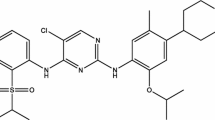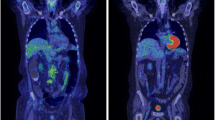Summary
Anaplastic lymphoma kinase 1 (ALK-1) is a member of the insulin receptor tyrosine kinase family. In clinical practice, three small molecule inhibitors of ALK-1 are used, namely crizotinib, ceritinib and alectinib. Several more agents are in active pre-clinical and clinical studies. Crizotinib is approved for the treatment of advanced ALK-positive non-small cell lung cancer (NSCLC). According to the package insert and published literature, treatment with crizotinib appears to be associated with kidney failure as well as an increased risk for the development and progression of renal cysts. In addition, this agent is associated with development of peripheral edema and rare electrolyte disorders. This review focuses on the adverse renal effects of Crizotinib in clinical practice.
Similar content being viewed by others
References
Orscheschek K, Merz H, Hell J, Binder T, Bartels H, Feller AC (1995) Large-cell anaplastic lymphoma-specific translocation (t[2;5] [p23;q35]) in Hodgkin’s disease: indication of a common pathogenesis? Lancet 345(8942):87–90
Ullrich A, Schlessinger J (1990) Signal transduction by receptors with tyrosine kinase activity. Cell 61(2):203–212
Roskoski R Jr (2013) Anaplastic lymphoma kinase (ALK): structure, oncogenic activation, and pharmacological inhibition. Pharmacol Res 68(1):68–94
Bullrich F, Morris SW, Hummel M, Pileri S, Stein H, Croce CM (1994) Nucleophosmin (NPM) gene rearrangements in Ki-1-positive lymphomas. Cancer Res 54(11):2873–2877
Pillay K, Govender D, Chetty R (2002) ALK protein expression in rhabdomyosarcomas. Histopathology 41(5):461–467
Chen Y, Takita J, Choi YL, Kato M, Ohira M, Sanada M et al (2008) Oncogenic mutations of ALK kinase in neuroblastoma. Nature 455(7215):971–974
Shinmura K, Kageyama S, Tao H, Bunai T, Suzuki M, Kamo T et al (2008) EML4-ALK fusion transcripts, but no NPM-, TPM3-, CLTC-, ATIC-, or TFG-ALK fusion transcripts, in non-small cell lung carcinomas. Lung Cancer 61(2):163–169
American Cancer Society (2015) Cancer facts & figures 2015. American Cancer Society, Atlanta
Ferlay J, Soerjomataram I, Dikshit R, Eser S, Mathers C, Rebelo M et al (2015) Cancer incidence and mortality worldwide: sources, methods and major patterns in GLOBOCAN 2012. Int J Cancer 136:E359–E386
Ettinger D, Akerley W, Bepler G, Blum M, Chang A, Cheney R et al (2010) Non-small cell lung cancer. J Natl Compr Cancer Netw 8:740–801
Larsen J, Cascon T, Gerber D, Heymach J, Minna J (2011) Targeted therapies for lung cancer: clinical experience and novel agents. Cancer J 17:512–527
Soda M, Choi YL, Enomoto M, Takada S, Yamashita Y, Ishikawa S et al (2007) Identification of the transforming EML4-ALK fusion gene in non-smal-cell lung cancer. Nature 448:561–566
Mano H (2008) Non-solid oncogenes in solid tumors: EML4-ALK fusion genes in lung cancer. Cancer Sci 99:2349–2355
Horn L, Pao W (2009) EML4-ALK: honing in on a new target in non-small-cell lung cancer. J Clin Oncol 27:4232–4235
Shaw AT, Yeap BY, Mino-Kenudson M et al (2009) Clinical features and outcome of patients with non-small-cell lung cancer who harbor EML4-ALK. J Clin Oncol 27:4247–4253
Camidge DR, Doebele RC (2012) Treating ALK-positive lung cancer—early successes and future challenges. Nat Rev Clin Oncol 9:268–277
Blackhall FH, Peters S, Bubendorf L et al (2014) Prevalence and clinical outcomes for patients with ALK-positive resected stage I-III adenocarcinoma: results from the European Thoracic Oncology Platform Lungscape Project. J Clin Oncol 32:2780–2787
Sullivan I, Planchard D (2016) ALK inhibitors in non-small cell lung cancer: the latest evidence and developments. Ther Adv Med Oncol 8(1):32–47
Solomon B, Mok T, Kim D, Wu Y, Nakagawa K, Mekhail T et al (2014) First-line crizotinib versus chemotherapy in ALK-positive lung cancer. N Engl J Med 371:2167–2177
Camidge D, Bang Y, Kwak E, Iafrate A, Varella-Garcia M, Fox S et al (2012) Activity and safety of crizotinib in patients with ALK-positive non-small-cell lung cancer: updated results from a phase 1 study. Lancet Oncol 13:1011–1019
Christensen JG, Zou HY, Arango ME et al (2007) Cytoreductive antitumor activity of PF-2341066, a novel inhibitor of anaplastic lymphoma kinase and c-Met, in experimental models of anaplastic large-cell lymphoma. Mol Cancer Ther 6(12 Pt 1):3314
Li C, Alvey C, Bello A et al. (2011) Pharmacokinetics (PK) of crizotinib (PF- 02341066) in patients with advanced non-small cell lung cancer (NSCLC) and other solid tumors. J Clin Oncol 29(Suppl):abstract e13065
FDA (2011) Prescribing information. Xalkori (crizotinib) or capsules. Pfizer labs, New York, Available from: http://www.accessdata.fda.gov/ drugsatfdadocs/label/2011/202570s000lbl.pdf. [Last accessed on 2013 Mar 6
US Food and Drug Administration (2013) Approval history XALKORI, NDA no. 202570, http://labeling.pfizer.com/showlabeling.aspx?id=676. Accessed November 15, 2013
Ou SHI, Salgia R, Clark J (2010) Comparison of crizotinib (PF-02341066) pharmacokinetics between Asian and non-Asian patients with advanced malignancies. J Thorac Oncol 5(Suppl 5):S382
Camidge DR, Bang Y, Kwak EL, et al. (2011) Progression-free survival (PFS) from a phase 1 study of crizotinib (PF-02341066) in patients with ALK positive non-small cell lung cancer (NSCLC). J Clin Oncol 29(Suppl):abstract 2501
Tabernero J, Elez M, Herranz M et al (2014) A pharmacodynamics/pharmacokinetic study of Ficlatuzumab in patients with advanced solid tumors and liver metastases. Clin Cancer Res 20:2793–2804
Brosnan EM, Weickhardt AJ, Lu X, Maxon DA, Barón AE, Chonchol M (2013) Drug-induced reduction in estimated glomerular filtration rate in patients with ALK-positive non-small-cell lung cancer treated with the ALK inhibitor crizotinib. Cancer. doi:10.1002/cncr.2847
Murata K, Baumann NA, Saenger AK, Larson TS, Rule AD, Lieske JC (2011) Relative performance of the MDRD and CKD-EPI equations for estimating glomerular filtration rate among patients with varied clinical presentations. Clin J Am Soc Nephrol 6:1963–1972
Earley A, Miskulin D, Lamb EJ, Levey AS, Uhlig K (2012) Estimating equations for glomerular filtration rate in the era of creatinine standardization: a systematic review. Ann Intern Med 156:785–795
Gastaud L, Ambrosetti D, Otto J, Marquette CH, Coutts M, Hofman P et al (2013) Acute kidney injury following crizotinib administration for non-small-cell lung adenocarcinoma. Lung Cancer 82:362–364
Martorell PM, Alvaro MH, Salguero MAS, Molla AI (2014) Crizotinib and renal insufficiency: a case report and review of the literature. Lung Cancer 84:310–313
Ciarimboli G, Lancaster CS, Schlatter E et al (2012) Proximal tubular secretion of creatinine by organic cation transporter OCT2 in cancer patients. Clin Cancer Res 18:1101–1108
Breyer MD, Qi Z (2010) Better nephrology for mice–and man. Kidney Int 77:487–489
Urakami Y, Kimura N, Okuda M, Inui K (2004) Creatinine transport by basolateral organic cation transporter hOCT2 in the human kidney. Pharm Res 21:976–981
Burgess E, Blair A, Krichman K, Cutler RE (1982) Inhibition of renal creatinine secretion by cimetidine in humans. Ren Physiol 5:27–30
van Acker BA, Koomen GC, Koopman MG, de Waart DR, Arisz L (1992) Creatinine clearance during cimetidine administration for measurement of glomerular filtration rate. Lancet 340:1326–1329
Kastrup J, Petersen P, Bartram R, Hansen JM (1985) The effect of trimethoprim on serum creatinine. Br J Urol 57:265–268
Myre SA, McCann J, First MR, Cluxton RJ Jr (1987) Effect of trimethoprim on serum creatinine in healthy and chronic renal failure volunteers. Ther Drug Monit 9:161–165
Naderer O, Nafziger AN, Bertino JS Jr (1997) Effects of moderate-dose versus high-dose trimethoprim on serum creatinine and creatinine clearance and adverse reactions. Antimicrob Agents Chemother 41:2466–2470
Opravil M, Keusch G, Luthy R (1993) Pyrimethamine inhibits renal secretion of creatinine. Antimicrob Agents Chemother 37:1056–1060
Camidge DR, Brosnan EM, DeSilva C, Koo PJ, Chonchol M (2014) Crizotinib effects on creatinine and non-creatinine-based measures of glomerular filtration rate. J Thorac Oncol 9(11):1634–1637
Whelan TF (2010) Guidelines on the management of renal cyst disease. Can Urol Assoc J 4:98–99
Carrim ZI, Murchison JT (2003) The prevalence of simple renal and hepatic cysts detected by spiral computed tomography. Clin Radiol 58:626–629
Minor LD, Picken MM, Campbell SC (2003) Pp. 170–171 in AUA update series (Vol. 22): benign renal tumors. American Urological Association, Houston, TX. Whelan TF. Guidelines on the management of renal cyst disease. Can Urol Assoc J. 2010;4:98–99
Bosniak MA (1986) The current radiological approach to renal cysts. Radiology 158:1–10
Israel GM, Bosniak AM (2005) An update of the Bosniak renal cyst classification system. Urology 66:484–488
Curry NS, Cochran ST, Bissada NK (2000) Cystic renal masses: accurate Bosniak classification requires adequate renal CT. AJR Am J Roentgenol 175:339–342
Eknoyan G (2009) A clinical view of simple and complex renal cysts. J Am Soc Nephrol 20:1874–1876
Mosharafa AA (2008) Prevalence of renal cysts in a Middle-Eastern population: an evaluation of characteristics and risk factors. BJU Int 101:736–738
Dong S, Patel N, Kundavaram C, Glassman D, Bagley D (2011) A contemporary study of renal cysts in a representative US population. Presented at the New England and Mid-Atlantic Sections of the American Urological Association 2011 Joint Annual Meeting, Orlando, FL, 3–5 November 2011. Available at http://meeting.neaua.org/abstracts/2011/6.cgi (accessed 4 November 2014)
Lin YT, Wang YF, Yang JC, Yu CJ, Wu SG, Shih JY et al (2014) Development of renal cysts after crizotinib treatment in advanced ALK-positive non-small-cell lung cancer. J Thorac Oncol 9(11):1720–1725
Schnell P, Bartlett CH, Solomon BJ, Tassell V, Shaw AT, de Pas T, Lee SH, Lee GK, Tanaka K, Tan W, Tang Y, Wilner KD, Safferman A, Han JY (2015) Complex renal cysts associated with crizotinib treatment. Cancer Med 4(6):887–896
XALKORI U.S (2014) Physician prescribing information. Available at http://labeling.pfizer.com/ShowLabeling.aspx?id=676. Accessed May 15, 2014
Shaw AT, Kim DW, Nakagawa K et al (2013) Crizotinib vs chemotherapy in advanced ALK-positive lung cancer. N Engl J Med 368(25):2385
Souteyrand P, Burtey S, Barlesi F (2015) Multicystic kidney disease: a complication of crizotinib. Diagn Interv Imaging 96(4):393–395
Sierra JR, Tsao MS (2011) c-MET as a potential therapeutic target and biomarker in cancer. Ther Adv Med Oncol 3(Suppl 1):S21–S35
Pisters LL, El-Naggar AK, Luo W, Malpica A, Lin SH (1997) C-met protooncogene expression in benign and malignant human renal tissues. J Urol 158(3 Pt 1):724–728
Horie S, Higashihara E, Nutahara K, Mikami Y, Okubo A, Kano M et al (1994) Mediation of renal cyst formation by hepatocyte growth factor. Lancet 344:789–791
Konda R, Sato H, Hatafuku F, Nozawa T, Ioritani N, Fujioka T (2014) Expression of hepatocyte growth factor and its receptor C-met in acquired renal cystic disease associated with renal cell carcinoma. J Urol 171:2166–2170
Zhou D, Tan RJ, Lin L, Zhou L, Liu Y (2013) Activation of hepatocyte growth factor receptor, c-met, in renal tubules is required for renoprotection after acute kidney injury. Kidney Int 84:509–520
Qin S, Taglienti M, Cai L, Zhou J, Kreidberg JA (2012) c-Met and NF-kappaBdependent overexpression of Wnt7a and -7b and Pax2 promotes cystogenesis in polycystic kidney disease. J Am Soc Nephrol 23:1309–1318
Cowley BD Jr, Rupp JC, Muessel MJ, Gattone VH 2nd (1997) Gender and the effect of gonadal hormones on the progression of inherited polycystic kidney disease in rats. Am J Kidney Dis 29(2):265–272
Jayapalan S, Saboorian MH, Edmunds JW, Aukema HM (2000) High dietary fat intake increases renal cyst disease progression in Han: SPRD-cy rats. J Nutr 130(9):2356–2360
Weickhardt AJ, Rothman MS, Salian-Mehta S, Kiseljak-Vassiliades K, Oton AB, Doebele RC, Wierman ME, Camidge DR (2012) Rapid onset hypogonadism secondary to crizotinib use in men with metastatic nonsmall cell lung cancer. Cancer 118(21):5302–5309
Author information
Authors and Affiliations
Corresponding author
Rights and permissions
About this article
Cite this article
Izzedine, H., El-Fekih, R.K. & Perazella, M.A. The renal effects of ALK inhibitors. Invest New Drugs 34, 643–649 (2016). https://doi.org/10.1007/s10637-016-0379-y
Received:
Accepted:
Published:
Issue Date:
DOI: https://doi.org/10.1007/s10637-016-0379-y




